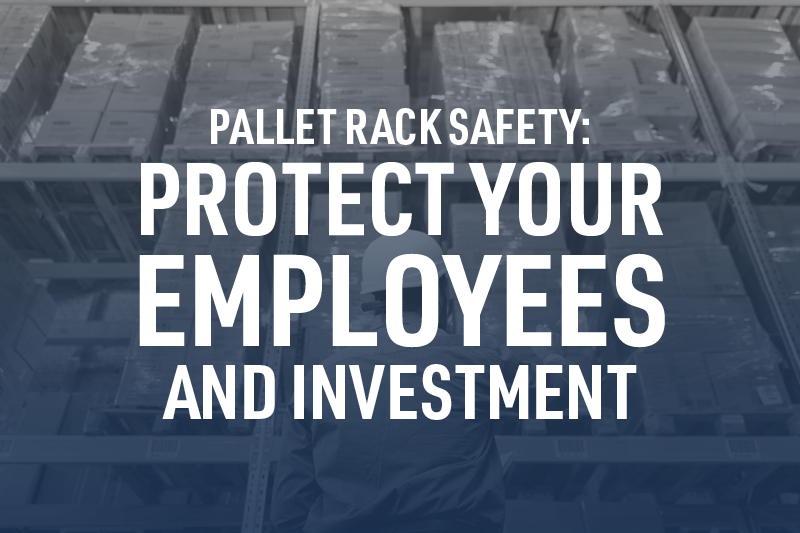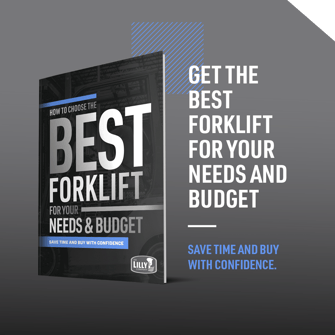3 min read
Pallet Rack Safety: Protect Your Employees and Investment
![]() Ken Lendermon
Nov 6, 2023 11:22:39 AM
Ken Lendermon
Nov 6, 2023 11:22:39 AM

If you ever played with blocks as a kid, you know that sometimes all it took was a little bump to knock the whole tower over. The same is true of your pallet racking. An impact on even a single unprotected upright can cause the whole system to collapse, and accidental collisions can be hard to eliminate in fast-paced warehouses.
You must defend your storage to protect your employees and your products. Pallet rack guards and protectors take the hit from those accidental forklift collisions, so your racking doesn’t have to. Read on to learn more about pallet racking protection equipment and how they improve warehouse safety.
Common Pallet Rack Damage
Standard 1926.250 outlines OSHA warehouse racking regulations. This standard dictates that all tiered storage will be secured in such a way as to prevent collapse and maintained in good repair. Unfortunately, even if your facility avoids a catastrophic collapse, damaged racking could still cost big bucks in OSHA fines.
To keep your employees safe and avoid expensive citations, watch for these common racking problems.
Bent Uprights
Dented uprights are one of the clearest indications of a hazard. Dents and bends are the result of an impact significant enough to affect the structural integrity of the racking. This kind of damage is common when a forklift collides with an unprotected upright and is often seen on used pallet racking.
Racks Out of Alignment
Even when a forklift collision doesn't dent the racking upright, it can knock it out of alignment. When an upright moves out of position, it is no longer capable of supporting its rated maximum load. This puts your whole pallet racking system in danger of a catastrophic collapse.
Unsecured Base Plates
Unsecured base plates are commonly a sign of DIY racking installation. When non-experts install pallet racking, they sometimes neglect to bolt down the base plates, not understanding how easily the uprights can shift during regular use. In other cases, base plates are knocked free from their bolts when a forklift strikes their upright. In either case, unsecured base plates are a sign of imminent disaster.
Pallet Rack Protection Accessories
70% of all pallet rack structural damage is due to forklift collisions. While some of these could be prevented with better forklift operator habits, genuine accidents do happen. So one of the easiest ways to protect your employees and products is installing physical guards against forklift impact. There are many racking protection systems on the market, but these are the most common.
Guard Rails
These are perhaps the most robust of the protection options available. Guard rails are installed at the ends of an aisle, creating a reinforced physical barrier between your racking and passing forklifts. These are similar to the guards you would use to protect production lines and in-warehouse offices.
End-Of-Aisle Guards
These guards also cover the end of your racking aisle. They are a C-shaped section of half-inch thick steel set slightly away from the racking itself. This space allows them to take a more substantial hit without damaging the uprights.
Upright Protectors
These steel protectors cover an individual upright. They are made of thinner steel than end-of-aisle guards, usually around a quarter inch thick, and they bolt directly to the floor. As a result, these offer the most protection for in-aisle uprights.
Snap-on Frame Protectors
These protectors secure directly to the upright itself. There is no space between the protector and the upright which means they offer the least impact protection of the 4. However, since they do not need to be bolted to the floor, they make excellent choices to protect sections above floor level. These also make excellent protectors for drive-in and drive-thru pallet racking.
Discover Hazards Before They Become Accidents
It can be challenging to notice hazardous damage to your racking. Dangerous dents may appear small, and familiarity with the space makes it easy to overlook these as routine wear and tear. That’s why periodic third-party racking inspections are so important. An outsider’s eye will notice damage that might have been missed by even the most conscientious in-house inspector.
If you are looking for a reliable third-party inspection, we can help. We offer free on-site consultations that will identify damage to your existing racking system and help you fix it and find the right equipment to protect your undamaged racks. To schedule your free assessment, contact us online or visit one of our Mid-South locations:
Arkansas - Jonesboro
Alabama - Birmingham, Dothan, Irondale, Madison, Mobile, and Montgomery
Mississippi - Tupelo, and Richland
Tennessee - Jackson, Memphis, Knoxville, and Kingsport
Further Reading
Different Types of Pallet Racking
Used Pallet Racking: Is It Worth The Risk?
Top 4 Forklift Operator Bad Habits
Posts by Tag
- Forklift (67)
- Forklift Service (19)
- Electric Forklifts (17)
- Forklift Safety (15)
- Warehouse Automation (13)
- Forklift Attachments (12)
- Product Review (12)
- Toyota Forklifts (12)
- Parts (10)
- Warehouse Planning (10)
- Clark Forklifts (8)
- Pallet Racking (8)
- Loading Docks (7)
- Material Handling Education (7)
- Purchasing Options (7)
- Aerial Equipment (6)
- Customer Solutions (6)
- Forklift Batteries (6)
- Forklift Rental (6)
- Forklift Tires (5)
- Heavy Equipment (5)
- Forklift Accessories (4)
- Forklift Fleet Management (4)
- Forklift Training (4)
- Pallet Jacks (4)
- Products (4)
- Utility Vehicles (4)
- Yard Spotter Trucks (4)
- Komatsu (3)
- Linde (3)
- Specialty Forklifts (3)
- Used Equipment (3)
- Warehouse Doors (3)
- IC Forklifts (2)
- Manitou (2)
- COMBiLift (1)
- Custom Shop (1)
- Forklift Brakes (1)
- Forklift Warranty (1)
- Gehl (1)
- Recruitment (1)










